Keywords: Central Air-Conditioning System; ZigBee Wireless Transmission; Platform Establishment; Data Monitoring; Data Analysis; Operation Optimization
Classification Number: TN926-34; TU831 Literature Identification Code: A Article Number: 1004-373X (2020) 24-0045-04
Application of ZigBee Wireless Transmission Technology in Central Air-Conditioning System
WU Xia1, GAO Yan1, 2 (1. Beijing Key Laboratory of Heating and Gas Supply, Ventilation and Air Conditioning Engineering, Beijing University of Civil Engineering and Architecture, Beijing 100044, China; 2. Beijing Advanced Innovation Center for Future Urban Design, Beijing 100044, China)
Abstract: In order to comprehend the operation status of the central air-conditioning system and optimize for the poor operation effect that may appear among them, a central air-conditioning system data monitoring platform based on ZigBee wireless transmission technology is established first to obtain real-time data of air-conditioning system operation, which has the characteristics of high reliability, high flexibility, and low energy consumption. By analyzing the monitoring data, it is found that the central air-conditioning system can produce continuous fluctuation of room temperature, is difficult to stabilize the set value, and has poor thermal comfort of the room when controlling the hot and humid environment of the room. The optimal control method for reducing the Kp parameter value of the PID controller of the water valve is proposed, which improves the operation effects of the central air-conditioning system. Keywords: central air-conditioning system; ZigBee wireless transmission; platform establishment; data monitoring; data analysis; operation optimization
1 Introduction
The widespread use of central air-conditioning systems in buildings has greatly improved the thermal comfort of indoor environments. However, in actual buildings, various issues such as uneven temperature and humidity, fluctuations in temperature, and delayed control often arise. Therefore, it is necessary to monitor the operation status of the central air-conditioning system in real-time to identify and resolve issues promptly, thereby improving operational control effectiveness.
Yang Huaiyi et al. proposed a method that combines data collected from temperature measurement points of air conditioners with circuit parameters to achieve real-time monitoring of cooling capacity, heating capacity, power, and energy efficiency of room air conditioning systems; Xu Qiangwei et al. used an Arduino microcontroller as the main controller for digital sensors and control devices to monitor air quality in subway station waiting areas; Bao Lingling et al. proposed a design idea for a comfort air conditioning automatic control system using PLC + inverter + configuration software, making the air conditioning system reliable, easy to operate, and feature-rich. In addition, Ai Hong et al. established a heating temperature monitoring system based on ZigBee wireless transmission, avoiding the difficulties of wired transmission and enabling real-time temperature monitoring of heating systems; O. P. Bodunde et al. applied ZigBee communication technology to water supply machinery, inferring the flow rate of pumps; Liu Yan combined ZigBee wireless communication modules with pressure and other terminal sensors to design and implement accurate detection of harmful gas concentrations; GUAN Yuxi et al. applied ZigBee communication technology to the perception and prevention of building fires, greatly improving fire safety levels. The aforementioned research on the applications of ZigBee fully demonstrates the broad application prospects of this technology in monitoring indoor thermal environments.
Currently, the data monitoring of central air-conditioning systems used to maintain the indoor thermal environment mainly adopts the following methods: using sensors to collect operational data from the central air-conditioning system and transmitting the data back to the control center via wired transmission, followed by data analysis and processing. Due to the complexity of the air conditioning system’s piping and the large number of rooms to be controlled, issues such as overly long electrical connections, difficult maintenance, high platform construction costs, and inconvenient later modifications arise. Therefore, this paper establishes a data monitoring platform for the central air-conditioning system based on ZigBee wireless transmission technology and optimizes operations based on the monitored data.
2 ZigBee Wireless Transmission Technology
ZigBee is a wireless data transmission network that can consist of a coordinator node, several routers, and terminal nodes. The communication distance ranges from a standard of 75 m to several hundred or even thousands of meters, and it supports unlimited expansion. ZigBee technology has strong networking capabilities, allowing for star, tree, and mesh network configurations.
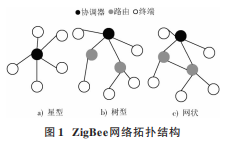
The ZigBee network is primarily established for data transmission in industrial equipment automation control, characterized by simplicity, reliability, and low cost. Specifically, it exhibits the following aspects: data is transmitted through wireless terminals, enabling free reconfiguration and flexible layout among nodes; when a new device is detected in the network, it can automatically update and optimize the network path and perform self-configuration; it can minimize interference between nodes, and terminal nodes can choose to adopt sleep-wake modes, entering sleep mode when not in operation to reduce energy consumption.
3 Data Monitoring of Central Air-Conditioning Systems
3.1 Central Air-Conditioning System Experimental Platform
The central air-conditioning system experimental platform mainly consists of a chiller, cooling tower, water pump, air conditioning box, and other equipment, as well as water and air systems; the terminal uses an air conditioning box to supply air for an all-air system; the control target is a room with an area of 36.8 m2. The air conditioning box is equipped with a PID controller that automatically adjusts the water valve opening based on the room temperature to ensure the room temperature remains stable at the set value. The control process is illustrated in Figure 2. Physical measurement points for water temperature, water pressure, valve position, and air temperature and humidity are reserved in the piping of the central air-conditioning system.

3.2 Data Monitoring Platform of Central Air-Conditioning Systems
The data monitoring platform adopts a star topology structure, including a coordinator node and 11 terminal nodes, with each terminal node connected to a sensor that monitors the supply and return temperatures of chilled water, supply and return temperatures of cooling water, flow rates of chilled and cooling water, inlet and outlet pressures of the pump, valve opening, air supply temperature and humidity, and room temperature and humidity. The data collected by each sensor is sent to the coordinator node via ZigBee wireless transmission technology through the connected terminal node. The coordinator node sends the data to a remote server via GPRS, processes the data according to the protocol, stores it in a database, and displays the processed values of various physical quantities on the interface program. The workflow of the data monitoring platform is shown in Figure 3, and the status of the data collection site is shown in Figure 4.

The ZigBee wireless transmission technology used in this data monitoring platform has strong anti-interference capability and high reliability; since all terminal nodes transmit data wirelessly and are powered by rechargeable batteries, the layout of wiring is reduced, providing high flexibility; terminal nodes only wake up to work during data transmission and automatically sleep at other times, reducing energy consumption, thus achieving low energy consumption; in addition, each terminal node is set to upload data at intervals of 10 s, which is very short compared to the changes in various physical quantities of the air conditioning system, allowing for real-time data acquisition.
3.3 Data Monitoring Process and Results
In the central air-conditioning system experimental platform, the maximum flow rate of chilled water is set to 3.02 m3/h, the supply temperature of chilled water is 7 ℃, the air supply volume is 3 200 m3/h, the air supply temperature is 18 ℃, and the room temperature is 26 ℃. The chiller, cooling tower, water pump, air conditioning box, and other equipment are turned on, and the valves in the piping are opened to ensure the normal operation of the central air-conditioning system experimental platform. Each terminal node, the coordinator node, and the server are activated to ensure the normal operation of the data monitoring platform. The monitored data is further organized, and part of the data is shown in Table 1.
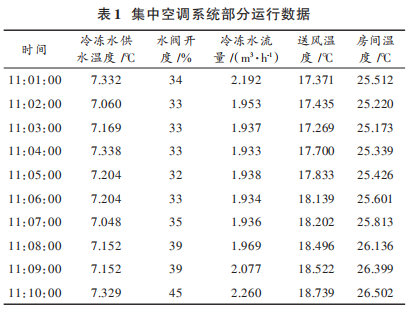
Further analysis of other monitored data reveals that the valve opening oscillates frequently, changing continuously within the range of 32%~55%, as shown by the dashed line in Figure 5; the room temperature fluctuates continuously between 24.8~27.4 ℃, making it difficult to stabilize at the set value, as shown by the solid line in Figure 5. Therefore, it can be concluded that the central air-conditioning system is not performing well when controlling the room at this time.
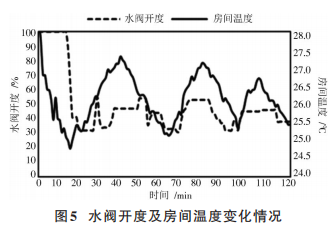
4 Operation Optimization of Central Air-Conditioning Systems
Analysis shows that frequent oscillation of the water valve leads to significant changes in the flow rate of chilled water; when the supply temperature of chilled water and the air supply volume remain unchanged, the continuous variation of the flow rate of chilled water causes fluctuations in the air supply temperature, ultimately leading to continuous fluctuations in room temperature, making it difficult to stabilize at the set value of 26 ℃. Therefore, to solve the problem of continuous fluctuations in room temperature, it is first necessary to understand the relative flow characteristics of the water valve opening to further analyze the relationship between changes in water valve opening, flow rate, and fluctuations in room temperature.
Keep the maximum flow rate of the chilled water system at 3.02 m3/h constant, manually adjust the water valve opening, monitor the flow data through the valve, and calculate the relative flow rate, which is the ratio of the flow through the valve to the maximum flow of the system when the valve is fully open. Based on the water valve opening and relative flow rate, a characteristic curve is plotted as shown in Figure 6. From Figure 6, it can be seen that this water valve is a fast-opening type; when the opening is below 50%, the flow rate changes rapidly, and the flow variation range caused by the change in water valve opening from 0~50% is 0~90%; when the water valve opening is above 50%, the flow rate changes slowly, and the flow variation range caused by the change in water valve opening from 50% to 100% is only 90% to 100%.
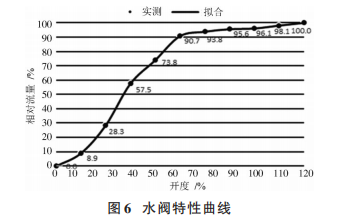
According to the data monitoring platform, the range of changes in the water valve opening during the operation of the central air-conditioning system is 32%~55%. It is evident that small changes in the opening lead to significant changes in the flow rate. Combining this with the mathematical model of PID control, and the significance of the control parameter KP (the KP value is the gain multiple of the output value to the deviation value; a larger ratio indicates a greater role in regulation, while too large a value can lead to system instability and continuous oscillation), it is speculated that the KP parameter in the water valve’s PID controller may be too large, causing excessive adjustments to the water valve when there is a slight deviation from the set room temperature, leading to significant changes in chilled water flow and ultimately resulting in continuous fluctuations in room temperature.

In the formula: U(t) is the controller output; KP is the proportional coefficient; TI is the integral time constant; TD is the differential time constant; e(t) is the deviation signal.
Attempt to reduce the KP parameter value. Based on the empirical tuning method for PID control parameters, the original KP=45 is adjusted to KP=33, aiming to reduce the adjustment range of the water valve and avoid excessive flow changes to improve the system’s instability and continuous oscillation. After adjusting the control parameters, the central air-conditioning system is run again, and the operational data is monitored through the data monitoring platform. At this point, the changes in water valve opening and room temperature are shown in the dashed and solid lines in Figure 7, respectively. It can be seen that the range of water valve opening changes is 33%~50%, and the adjustment range is relatively small and stable; the room temperature changes within the range of 25.1~26.8 ℃, which is a narrower range compared to before the optimization, and gradually stabilizes at 26 ℃. Therefore, the operational results of the central air-conditioning system have been optimized.
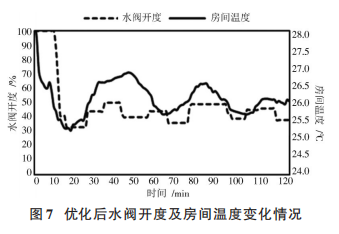
5 Conclusion
This paper establishes a data monitoring platform for central air-conditioning systems based on ZigBee wireless transmission technology. The platform has strong anti-interference capability and high reliability, utilizes wireless transmission, and terminal nodes and sensors are powered by rechargeable batteries, providing high flexibility; terminal nodes adopt a sleep-wake mode, resulting in low energy consumption. The platform monitors real-time data of water flow, water temperature, water pressure, valve opening, as well as air supply temperature and room temperature during the operation of the central air-conditioning system. Analyzing these data reveals that the excessive KP value in the water valve controller causes frequent fluctuations in room temperature, leading to poor thermal comfort. Therefore, appropriate methods to reduce the control parameters of the water valve have optimized the operational results of the central air-conditioning system.
References
[1] Yang Huaiyi, Ren Tao, Ding Guoliang, et al. Online monitoring method for air conditioning system performance based on limited measurement points. Refrigeration Science and Technology, 2018, 39(6): 70-76.
[2] Xu Qiangwei, Song Ruigang. Air quality monitoring and control device for subway station waiting areas. Light Industry Technology, 2019(8): 114-115.
[3] Bao Lingling, Zhao Yang, Wang Ziyong, et al. Application of PLC in automatic control systems of comfort air conditioning. Modern Electronic Technology, 2018, 41(18): 22-27.
[4] Ai Hong, Qiu Jingpeng. Research on temperature monitoring system for heating based on ZigBee wireless transmission. Modern Electronic Technology, 2018, 41(23): 113-117.
[5] BODUNDE O P, ADIE U C, IKUMAPAYI O M, et al. Architectural design and performance evaluation of a ZigBee technology based adaptive sprinkler irrigation robot. Computers and Electronics in Agriculture, 2019, 160: 168-178.
[6] Liu Yan. Detection of harmful gas concentrations in vehicles based on ZigBee communication and ARM controller. Journal of Chinese Academy of Electronics and Science, 2018, 13(6): 725-731.
[7] GUAN Yuxi, FANG Zheng, WANG Tianran. Fire risk assessment and daily maintenance management of cultural relic buildings based on ZigBee technology. Fire Science & Technology, 2018, 211: 192-198.
[8] Wang Dingao, Liu Qingquan, Dai Wei, et al. Energy consumption prediction and monitoring system for air conditioning based on BP neural network. Modern Electronic Technology, 2019, 42(22): 140-144.
[9] Liu Ji. Research on routing optimization algorithms for ZigBee networks. Jiangsu University, 2017.
[10] Hu Yi. Design of wireless temperature measurement system for traction substations based on ZigBee wireless transmission. Xi’an University of Technology, 2019.
[11] Wang Lei. Discussion on the application of ZigBee wireless transmission technology in the digital construction of oil fields. China Equipment Engineering, 2019(20): 231-232.
[12] Xu Yuanchao. Research on optimization control strategies for central air conditioning water systems. Nanjing University of Science and Technology, 2005.
[13] Pan Yiqun, Huang Sen, Liu Yudai. Frontier technologies and advanced applications for building energy consumption simulation. Beijing: China Building Industry Press, 2019.
WU Xia 1, GAO Yan 1, 2 (1. Beijing University of Civil Engineering and Architecture, Beijing 100044; 2. Beijing Advanced Innovation Center for Future Urban Design, Beijing 100044)
Author Information: WU Xia (1994—), female, graduate student, majoring in the operation control of central air-conditioning systems. GAO Yan (1973—), male, PhD, professor, majoring in control of central air-conditioning systems and efficient utilization of composite energy.